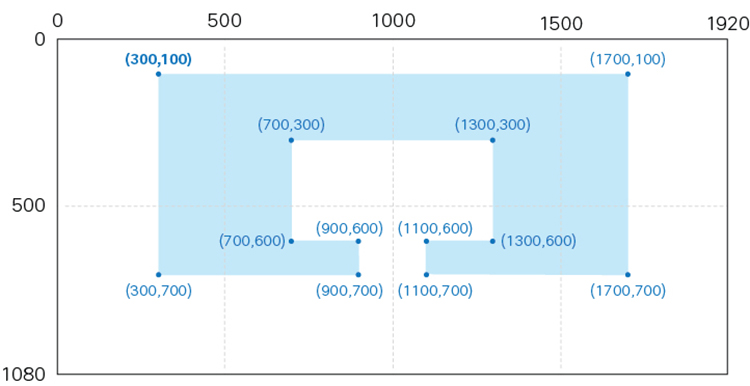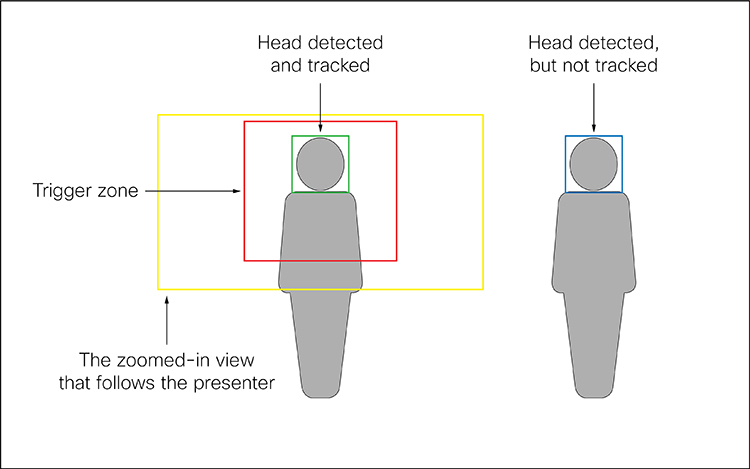- Home
- /
- Article

Set up PresenterTrack for Board and Room Series
 In this article
In this article Feedback?
Feedback?The PresenterTrack feature enables the camera to follow a presenter that is moving about on stage. The tracking stops when the presenter leaves the stage. You can set up the feature from the local device web interface.
The following devices and cameras support PresenterTrack:
-
Board Pro and Board Pro G2 with PTZ 4K
-
Codec EQ and Room Kit EQX with Room Vision PTZ, PTZ 4K, or Precision 60 camera
-
Codec Pro with Room Vision PTZ
-
Codec Plus and Codec Pro with PTZ 4K, Precision 60, or SpeakerTrack 60 camera
-
Room Bar Pro with PTZ 4K
-
Room 55 Dual, Room 70, and Room 70 G2 with PTZ 4K or Precision 60 as external camera
Watch this video for a walkthrough of the PresenterTrack setup with Cross-view camera.
Room Vision PTZ PresenterTrack
The new PresenterTrack experience developed for Room Vision PTZ delivers high quality production for the bigger stage. It uses built in AI and moveable pan, tilt and optical zoom for great image quality.
Click here for more information on room considerations and software setup.
Capabilities and limitations
-
Once set up, you activate and deactivate PresenterTrack from the camera panel on the touch controller.
-
The camera uses digital pan, tilt, and zoom, so it doesn’t move physically while tracking the presenter.
-
PresenterTrack supports the tracking of one or more persons on stage. If they stand too far apart to fit within a zoomed view, the camera zooms out to show the full stage.
-
You can use PresenterTrack as a standalone feature, or as part of the presenter and audience, briefing room, and classroom setups.
-
You can set up a device to use one of the cameras in a SpeakerTrack 60 camera assembly for PresenterTrack.
-
You cannot use PresenterTrack and speaker tracking simultaneously. When you activate PresenterTrack, speaker tracking is disabled automatically; when you activate speaker tracking, PresenterTrack is disabled automatically.
There is one exception to this: In the presenter and audience, briefing room, and classroom setups both features are active simultaneously in the Q&A mode (when someone in the local audience asks a question while a local presenter is on stage).
Considerations before placing the camera
When you set up PresenterTrack, you must define a stage area and a trigger zone. Consider the location and use of these areas when placing the camera that is tracking the presenter on stage.
Stage area: The stage area is the zoomed-out overview image.
-
Make it large enough so that the presenter can move about on stage. The tracking stops when the presenter leaves the stage area.
-
Allow the audience or meeting participants to move naturally in the room without triggering the tracking.
Trigger zone: Presenter tracking doesn't start before the camera detects a head in the trigger zone.
-
Choose a location where the presenter naturally enters the stage, for example by a presenter table or podium.
-
Make the zone large enough for the camera to detect the presenter's head.
-
To avoid a false head detection, make sure that the background of the trigger zone is neutral. Avoid having the trigger zone in front of a screen.

Set up PresenterTrack
Before you begin
We recommend you to be in the same room as the device and camera while setting up PresenterTrack.
| 1 |
From the customer view in https://admin.webex.com, go to the Devices page, and click on your device in the list. Under Support, click Local Device Controls to launch the local device web interface. If you have set up an Admin or Integrator user locally on the device, you can access the device web interface directly. Just open a web browser and type in http(s)://<device ip or hostname>. |
| 2 |
Go to Settings and open the Configurations tab. For the connector (N) that you have connected the camera to, set to camera, and to On.
When configuring the Precision 60 over SDI for PresenterTrack, you need to disable camera control on Input 2 and instead enable it on Input 6. When using the Cisco PTZ 4K, make sure the output resolution for the camera is set to 4K by configuring to 3840_2160_30. Go in and out of standby for the configuration to work. When the Ciso PTZ 4K is set to 4K, you also need to set to Limited. Make sure to set on the connectors where the PTZ 4K are connected. |
| 3 |
Go to Settings, open the Audio and Video tab, and click Presenter Track. |
| 4 |
Turn on Enable PresenterTrack and click Configure to open the configuration page. Opening this page deactivates standby and presenter tracking, enables the self-view in full screen, and shows the trigger zone rectangle on the screen of the device. Don't leave this web page without clicking Done, otherwise the trigger zone rectangle stays visible on the screen of the device. (If you forget, you can remove the rectangle like this: For Board and Room Series, open the control panel on the device's user interface, tap Camera, and choose a new camera mode or preset. For SX and MX Series, tap the Camera icon on the touch controller and choose a camera position from the list.) |
| 5 |
For Board and Room Series, on the device's user interface, open the control panel, tap Camera followed by Manual, and choose the correct camera from the drop down list. For SX and MX Series, on the device's user interface, choose a camera from the Camera source drop down list. Then, for all devices, use the camera controls (zoom, pan, tilt) to define the stage area. You see a notification if the camera does not support the PresenterTrack feature. |
| 6 |
A blue dashed rectangle, which represents the trigger zone, is shown on the device web interface. Move and resize the rectangle while watching the device's screen. You see the same rectangle overlaying the camera self-view. Place the rectangle where you want the trigger zone to be. If you want to set up a more advanced polygonal trigger zone, see the Set up a polygonal trigger zone section. |
| 7 |
Click Done. |
| 8 |
For Board and Room Series, open the control panel and choose Camera followed by Presenter. For SX and MX Series, tap the Camera icon in the upper right corner of the touch controller and choose Presenter from the list of camera positions. This activates presenter tracking.
|
| 9 |
Position yourself in the trigger zone and see that the camera zooms in on you. Walk about on the stage and check that the camera view follows you. Also check that presenter tracking stops when you leave the stage. If something fails, go back to step 4, 5, and 6 to adjust the size and location of the stage area and trigger zone. For more troubleshooting help, you can switch on PresenterTrack diagnostics mode, as described in the Diagnostics mode section. |
Set up a polygonal trigger zone
You can set up only rectangular trigger zones from the Presenter Track web page. If you want to define a more advanced polygonal trigger zone, you must set the configuration (read the Advanced Settings article for information how to access the configurations of the device).
The value of this setting is a string that contains the coordinate pairs of all the vertices of a polygon.
Example: Define the following trigger zone, which has 12 vertices. The diagram shows the coordinates of all the vertices. Such a trigger zone may be convenient if there is a screen, which you want to avoid, behind the presenter.

Starting from the upper left vertex and going clockwise, the corresponding value for is:
"300,100,1700,100,1700,700,1100,700,1100,600,1300,600,1300,300,700,300,700,600,900,600,900,700,300,700"Diagnostics mode
The PresenterTrack diagnostics mode may be a helpful tool when troubleshooting an issue. In order to set the device in diagnostics mode, you have to run an API command. Read the Access the API article for information how to use the API.
The following command sets the device in PresenterTrack diagnostics mode:
xCommand Cameras PresenterTrack Set Mode: DiagnosticIn this mode, you see the stage area (the zoomed-out overview image) on the screen, and an overlay with the following indicators:
-
RED frame: The trigger zone.
-
YELLOW frame: The zoomed-in view of the presenter.
-
GREEN frame: A head that is detected and tracked.
-
GREEN or RED blinking filled frame: Head detections. Green color indicates a high confidence, red color indicates a low confidence.
-
BLUE frame: A head that is detected, but not tracked.



